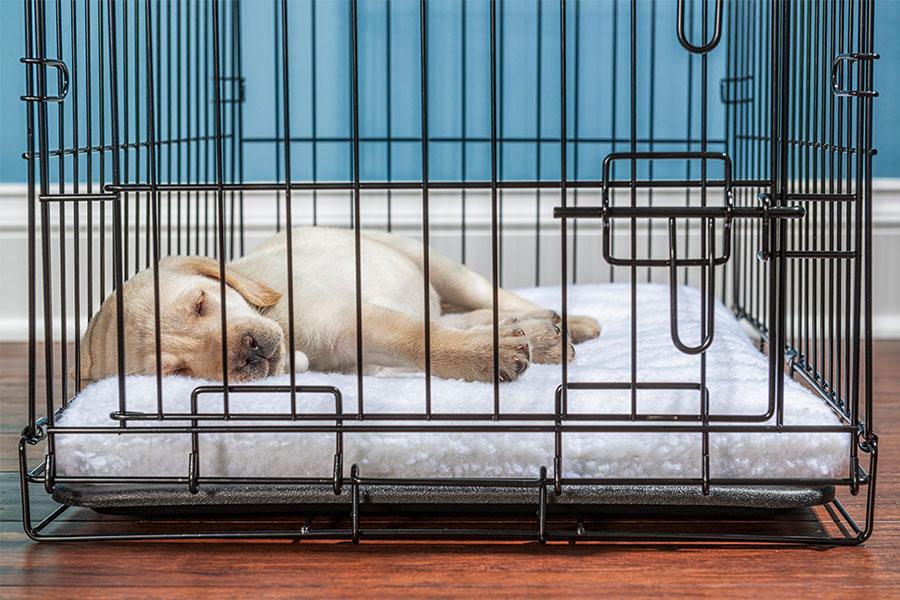When the sun sets and the world quiets down, a new adventure begins for both you and your furry friend. As the stars twinkle overhead, the gentle rustle of tiny paws can be heard, signaling the start of a night filled with growth and learning. Puppy crate training at night is not just a practical step in your young companion’s journey; it’s a vital bonding experience that nurtures trust, security, and routine. As you embark on this process, understanding the nuances of nighttime crate training can pave the way for peaceful slumbers and happier days ahead. Whether you’re a first-time puppy parent or adding a new member to your family, this guide will illuminate the path to a restful night for you both, ensuring that your puppy feels safe and cherished in their new home.
Table of Contents
- Understanding the Benefits of Crate Training for Nighttime Rest
- Establishing a Nighttime Routine: Steps for Successful Crate Training
- Creating a Comfortable Crate Environment for Your Puppy
- Troubleshooting Common Challenges During Nighttime Crate Training
- Q&A
- The Conclusion
Understanding the Benefits of Crate Training for Nighttime Rest
Crate training can be a game changer for your puppy’s nighttime rest, offering a multitude of benefits that foster a sense of security and well-being. When a puppy is introduced to a crate, it becomes a safe haven where they can retreat, relax, and feel protected. This practice not only helps in managing their anxious tendencies but also establishes a routine that can improve their overall sleeping patterns. The confined space of the crate mimics the natural den-like environment dogs instinctively seek, promoting calmness and reducing stress, which is crucial for restful nights.
Additionally, crate training encourages healthy habits, making it easier for both owners and puppies to enjoy undisturbed nighttime rest. Here are some key advantages:
- Promotes bladder control: Puppies learn to hold their bladder, helping with house training.
- Reduces nighttime disturbances: A comfortable crate can minimize barking and whimpering, leading to peaceful sleep for both puppy and owner.
- Establishes a bedtime routine: Creating a consistent schedule fosters better sleep habits for your puppy.
- Encourages independence: Puppies learn to enjoy time alone, which can reduce separation anxiety.
Establishing a Nighttime Routine: Steps for Successful Crate Training
Creating a Comfortable Crate Environment for Your Puppy
When setting up a crate for your puppy, comfort is key to fostering a sense of safety and security. Begin by selecting a crate of appropriate size; it should be spacious enough for your puppy to stand, turn around, and lie down comfortably, but not so large that they feel lost inside it. Add a cozy blanket or a soft bed to create an inviting atmosphere. Consider including a few safe toys to keep them entertained and help ease the transition into their new space. Here are some essentials to enhance their crate environment:
- Soft bedding: Provides warmth and comfort.
- Toys: Keeps your puppy busy and entertained.
- Water bowl: If left for extended periods, ensure hydration.
- Familiar items: Include a piece of clothing with your scent for reassurance.
Maintaining a calm and soothing environment is just as important. Use calming techniques to help your puppy feel more secure at night. Play soft music or use a white noise machine to drown out unfamiliar sounds that may cause anxiety. Ensure the crate is located in a quiet area of your home, away from drafts and loud noises. For a better understanding of the ideal crate setup, refer to the table below:
| Item | Purpose |
|---|---|
| Cozy Blanket | Provides warmth and comfort. |
| Safe Toys | Keeps your puppy entertained. |
| Water Bowl | Ensures hydration overnight. |
| Calming Music | Reduces anxiety and promotes relaxation. |
Troubleshooting Common Challenges During Nighttime Crate Training
Cascading challenges can arise during nighttime crate training, yet understanding these common issues is the first step toward finding effective solutions. Many puppies may initially resist their crate, exhibiting behaviors such as whining, barking, or scratching at the door. This can stem from an innate instinct to stay close to their owners or simply a lack of familiarity with their new sleeping space. To address these behaviors, consider the following strategies:
- Gradual Introduction: Start by letting your puppy explore the crate during the day, making it a positive space.
- Comfort Items: Place their favorite toys or a blanket inside to create a cozy environment.
- Time Limitations: Keep initial crate sessions short, gradually increasing the duration as your puppy acclimates.
Another frequent issue is nighttime accidents, which can occur if a puppy hasn’t yet developed full bladder control. To minimize the likelihood of such mishaps, establish a consistent evening routine that includes a final bathroom break just before bedtime. Eyeing the puppy’s behavior can also help; sniffing around or circling may indicate their need to go out. Below is a helpful table summarizing tips to ensure successful nighttime crate training:
| Tip | Description |
|---|---|
| Routine | Stick to a consistent schedule for meals and bathroom breaks. |
| Bedtime Cues | Use specific cues or commands to signal bedtime. |
| Positive Reinforcement | Praise and reward your puppy when they settle down in the crate. |
Q&A
Q&A: Navigating Puppy Crate Training at Night
Q: Why should I crate train my puppy at night?
A: Crate training at night can provide a safe, designated space for your puppy to rest while helping them develop a routine. It mimics a den-like environment that dogs naturally seek, reducing anxiety. Additionally, it aids in potty training by teaching your puppy to hold their bladder until morning.
Q: How do I introduce my puppy to the crate for nighttime use?
A: Start by placing the crate in a quiet area where your puppy can feel secure. Encourage them to explore the crate by using treats or toys. Gradually increase the time they spend inside during the day, so they associate it with positive experiences before attempting nighttime confinement.
Q: How can I make my puppy comfortable in the crate at night?
A: Make the crate a cozy retreat by adding soft bedding and a favorite toy. You might even consider a blanket or shirt with your scent to provide additional comfort. Keeping the crate near your bedroom can also help your puppy feel secure, knowing you are close by.
Q: What should I do if my puppy cries or whines in the crate at night?
A: It’s natural for puppies to express distress when first crate training. Resist the urge to let them out immediately; instead, give them a few moments to settle down. If the crying persists, you can assess whether they need to go potty. Remember, consistency and patience are key—over time, they will learn that nighttime is for sleeping.
Q: Will my puppy always need to sleep in a crate at night?
A: Not necessarily! As your puppy matures and becomes more accustomed to their environment, you might find that they feel comfortable sleeping outside the crate. Many owners transition their dogs to free-roaming at night once they demonstrate good potty habits and understand boundaries.
Q: How long can my puppy stay in the crate at night?
A: Although it varies by age, puppies generally can be crated for a duration equivalent to their age in months plus one hour. For instance, a 3-month-old puppy can typically hold it for 4 hours. As your puppy grows, they will be able to comfortably stay in the crate longer.
Q: What if my puppy has accidents in the crate during the night?
A: Accidents can happen, especially during potty training. Be sure to clean the crate thoroughly to eliminate any lingering odors. If accidents are frequent, consider adjusting the crate schedule, ensuring your puppy has ample bathroom breaks before bedtime. And remember, patience is key!
Q: Are there any specific crate training tips for the first night?
A: Absolutely! On the first night, take your puppy for a thorough bathroom break just before crating. Be prepared for some initial fussing, but maintain a calm demeanor, gently encouraging your puppy to settle down. It can also help to have a simple nighttime routine, signaling that it’s time to sleep.
Q: How can I reinforce positive behavior during crate training?
A: Use treats and praise as powerful motivators. Whenever your puppy enters the crate calmly, shower them with affection and rewards. This positive reinforcement helps create a strong association between the crate and good feelings, making them more likely to embrace their nighttime haven.
Q: What are common misconceptions about puppy crate training at night?
A: A prevalent misconception is that crating is cruel. In reality, when done properly, crate training can provide comfort and security for your puppy. It’s also important to remember that you shouldn’t use the crate for punishment; it should be a place of positive association.
By following these guidelines and maintaining a loving, patient approach, you can make nighttime crate training a positive experience for both you and your new puppy!
The Conclusion
puppy crate training at night is a journey that requires patience, consistency, and a sprinkle of love. As you guide your furry friend through the nighttime routine, remember that each bark and whimper is just a step toward building trust and security in their new environment. The crate, once seen as a simple enclosure, will transform into a cozy haven where your pup can feel safe and at ease. By establishing a calming nighttime ritual and celebrating the small victories, you will not only help your puppy adjust to their crate but also enhance the bond you share. So, as you tuck your little one in for the night, rest assured that you are laying the foundation for a well-behaved companion who is ready to greet the world with wagging tails and boundless joy. Sweet dreams to both you and your puppy!



